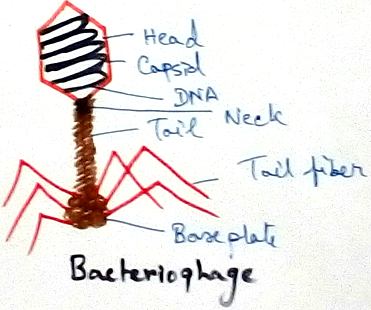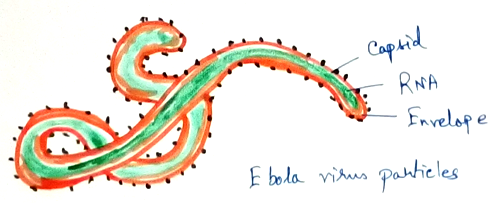Virus
Element which is between the state of living and nonliving, a cellular, disease producing, parasitic in nature, living state is observed only within living cell and able to reproduce only within living cell is called virus.
Structure of virus- According to shape virus can be of different shape. Those are spherical (polio virus), rodshaped (TMV), ovoid (influenza virus), cuboidal (Variola virus), spermatozoa shaped (bacteriophage).
One entire virus molecule is known as virion. Entire virus body can be divided into
1. Capsid,
2. Virus genome.
1. Capsid: Outer most covering of virus is known as capsid. It consists of capsomere, which is the subunit of capsid. Virus may covered with capsid or may be without capsid. Capsids are mainly made up of proteins, nut in some cases other materials like carbohydrate (TMV), fat and starch (Influenza virus), protein (vaccinia virus), lysozyme (bacteriophage), neuraminidase (Influenza virus).
Virus without capsid are called Lipo virus (Harpies virus.). Subunit of capsid is pelpomere. In some cases spike are observed which is made up of haemaglutinin and acts as antigen. When it enters the host body, it converts the RBC into mass. Viruses without capsid are called viriod. Here envelope is observed.
2. Nucleoid- This is consist of nucleic acid which is covered by capsid.Virus contains DNA or RNA or both DNA and RNA.
Bacteriophage has a special type of structure. It can be divided into different parts. They are head, neck, tail, end plate. First it injects genetic material into host body .There it proliferateto give rise in number.
Reproductive materials of different virus are-
1. DNA- here genetic material is DNA. DNA virus can be two types according to the presence of number of strand.
Single stranded- Gemini virus.
Double stranded- Variola virus.
2. RNA - here genetic material is RNA. According to presence of strand RNA virus can be two type-
Single stranded- Tobacco mosaic virus (TMV)
Double stranded- Rio virus.
3. DNA and RNA – initially the genetic material is RNA but when virus entered the living cell, RNA is converted into DNA by reverse transcriptase enzyme. E.g. Ross sarcoma.
Generally animal disease producing virus are DNA virus and plant disease producing virus are plant virus.
Virus living or nonliving?
In virus both characteristics of living and nonliving are observed.
Nonliving Characteristics of virus are-
(i) Do not contain any cytoplasm.
(ii) Unable to respond to any external stimulus.
(iii) cellular metabolism is absent in virus.
(iv) Virus don’t have any locomotion.
(v) They cannot reproduce outside the living cell.
Living characteristics of virus-
(i) Virus contains nucleic acid and protein.
(ii) Virus is able to reproduce in a living cell.
Four common diseases caused by virus –
Small pox - small pox spreads from oral, nasal, vesicular discharges, pustules and scabs. Brick shaped DNA virus Variola virus causes this diseases.
Measles - this disease caused by RNA containing virus called Rubella virus or Polynosa morbillorum.
Polio - polio- is caused RNA virus called Polio- virus.
Influenza– influenza is caused by Myxovirus influenza.
Questions and answers on Virus:
1. What is bacteriophage?
Virus that attack bacteria are called bacteriophage.
2. What is actinophage?
Virus that attack actinomycetes are called actinophage.
Recent Articles
-
What Is Plasma? | Blood Plasma | Proteins | Nutrients | Cholesterol
Nov 07, 25 10:29 AM
Blood is a mobile fluid which is a connective tissue and is derived from the mesoderm like cell any other connective tissue. Colour of blood is reddish and that flows inside the blood vessels by means… -
Disorders of Respiratory System | Tuberculosis | Pleurisy | Emphysema
Oct 28, 25 11:39 PM
Tuberculosis is very common disease and is caused by a type of bacteria called Mycobacterium tuberculosis. This disease causes different trouble in the respiration and infection of several parts of th… -
Regulation of Respiration | Respiratory Centres | Inspiratory Area |
Oct 14, 25 12:13 AM
Respiratory Centre is the area that controls the rate of respiration and it is observed to be located in medulla oblongata and pons. Respiratory Centre has the following will dispersed components like… -
Explain Transport of Gases | External Respiration | Tissue Respiration
Oct 09, 25 11:35 PM
In humans gaseous exchange is completed in the following ways the steps are - External Respiration or Breathing - Breathing in false taking in of Oxygen and giving out of carbon dioxide in the body. M… -
Kind and Number of Teeth | Location of Teeth in Mouth | Care of Teeth
Sep 11, 25 12:52 AM
Kind and Number of Teeth







New! Comments
Have your say about what you just read! Leave me a comment in the box below.